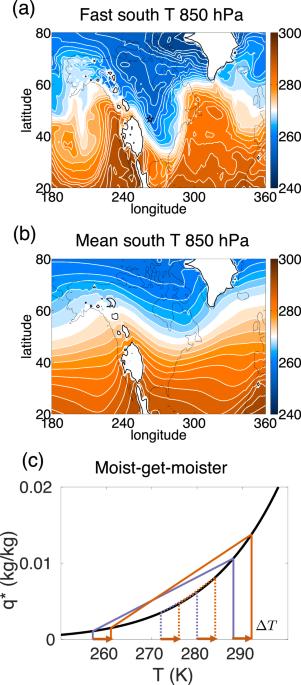快-变-快解释了气候变化导致高层喷流减弱的原因
IF 8.1
1区 地球科学
Q1 ENVIRONMENTAL SCIENCES
引用次数: 0
摘要
地球高层喷流主要向东流动。它们经常表现出与地表极端天气相关的南北向成分或摆动。最近研究发现,在气候变化的影响下,高层向东喷射气流表现出 "快-变-快 "的反应,其原因是非线性克劳修斯-克拉皮戎关系对纬度密度对比的影响。在这里,我们证明了快变快机制也适用于高层南北喷流风和纵向密度对比,这意味着在气候变化下波浪性增加。北极海冰的减少被认为是波状增加的驱动因素,但它无法解释这种反应。它导致在所有垂直水平上都出现了快变慢的波动响应。我们在南半球的再分析数据中证明了快变快的波动信号,但在北半球尚未出现。结果表明,"快-变-快 "机制解释了高层气流摆动的变化,并凸显了气候变化下高层和中层气流摆动之间的角力。气候变化导致两个半球的高层喷射气流摆动度增加,极端的向南和向北偏移比平均值增加得更快,这是连接摆动度和密度对比变化的 "快-变-快 "机制的结果。本文章由计算机程序翻译,如有差异,请以英文原文为准。

Fast-get-faster explains wavier upper-level jet stream under climate change
Earth’s upper-level jet streams primarily flow in the eastward direction. They often exhibit a north-south component or waviness connected to extreme weather at the surface. Recently the upper-level eastward jet stream was found to exhibit a fast-get-faster response under climate change explained by the impact of the nonlinear Clausius-Clapeyron relation on the latitudinal density contrast. Here we show the fast-get-faster mechanism also applies to the upper-level north-south jet stream wind and the longitudinal density contrast, implying increased waviness under climate change. Arctic Sea ice loss, which has been proposed as a driver of increased waviness, cannot explain the response. It leads to a fast-get-slower waviness response at all vertical levels. We demonstrate the fast-get-faster waviness signal has emerged in reanalysis data in the Southern Hemisphere but not yet in the Northern Hemisphere. The results show the fast-get-faster mechanism explains upper-level waviness changes and highlights a tug of war between upper- and mid-level waviness under climate change. Climate change causes upper-level jet stream waviness to increase in both hemispheres, with extreme southward and northward excursions increasing faster than the mean, according to results from a fast-get-faster mechanism connecting waviness to density contrast changes.
求助全文
通过发布文献求助,成功后即可免费获取论文全文。
去求助
来源期刊

Communications Earth & Environment
Earth and Planetary Sciences-General Earth and Planetary Sciences
CiteScore
8.60
自引率
2.50%
发文量
269
审稿时长
26 weeks
期刊介绍:
Communications Earth & Environment is an open access journal from Nature Portfolio publishing high-quality research, reviews and commentary in all areas of the Earth, environmental and planetary sciences. Research papers published by the journal represent significant advances that bring new insight to a specialized area in Earth science, planetary science or environmental science.
Communications Earth & Environment has a 2-year impact factor of 7.9 (2022 Journal Citation Reports®). Articles published in the journal in 2022 were downloaded 1,412,858 times. Median time from submission to the first editorial decision is 8 days.
 求助内容:
求助内容: 应助结果提醒方式:
应助结果提醒方式:


